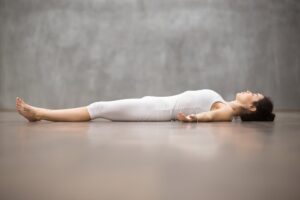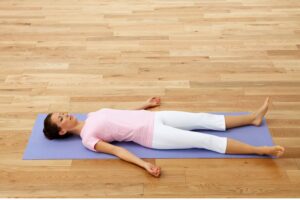SHAVASANA POSE
Shavasana (Sanskrit शवासन, śavāsana: शव, śava; आसन, āsana – ‘dead man’s pose’) is generally performed at the end of yoga practice and is also the main asana in Yoga-nidra and https://www.julianalucky.com/yoga-for-kids. It is a posture of rest and relaxation where the practitioner lies on their back, their body still and at peace. For some reason, some practitioners, upon completion of the class, avoid performing this asana, believing it to be useless and having no positive effects. As a rule, its benefits are not appreciated by practitioners who find it hard to calm the mind and relax the body muscles. What should we do in such a case? In this article we’re going to try to figure this out and talk about the benefits of Shavasana yoga and how to perform it correctly for beginners.
Shavasana pose in yoga
Shavasana is a state of consciousness where all the energy accumulated during the practice is assimilated and new neural connections in the brain are formed. A neural network is a set of functionally interconnected neurons of the central and peripheral nervous system. New motor-motor connections are formed during practice, and all of this information is processed and assimilated through the process of neuromuscular integration.
Shavasana pose in yoga can be practiced at the beginning of practice to calm the mind, release muscle tension and set the mood for the class, and even in the middle of practice, as well as between asanas as a rest pose to recover if necessary.
The technique of performing Shavasana is very simple. However, beginners may need guidance in mastering it at first, as not everyone in Shavasana is able to achieve a state of peace and relaxation. There may be many reasons, but the main reason is the inability to calm the mind and release muscle tension.
Also, before performing Shavasana, if you observe discomfort in your lower back and there is no feeling of tight contact with the surface of the mat, you should relax this area with the following exercises:
Do several rolls on your back left and right;
Bring your knees to your chest with your arms around your legs and hold that position for several breathing cycles until you feel your lower back muscles are relaxed;
With the left leg straight, pull the knee of the right leg to the chest, pressing the thigh tightly against the belly, then do the same, changing legs.
If these exercises did not help enough, you can put a bolster or a folded blanket under your knees – this will lift your knees and your lower back will be pressed tighter to the mat surface, thus the feeling of tension in it should go away.
Shavasana: technique.
Lie on your back.
The head, neck and spine are in one straight line.
The pelvis should be pressed to the floor.
If you experience tension in the neck area, put a folded blanket under the head so as to raise the head slightly.
Spread your arms and legs apart to a comfortable distance (about the width of the mat), palms of your hands open and facing upward – feel how the tension goes away through your palms.
Take a deep breath in and out. After breathing should be natural – while doing Shavasana there should be no control over your breathing, only if you feel drowsy, then concentration on the inhales and exhales is appropriate. It is important to remain awake during Shavasana and not to fall asleep – the practice of concentrating on the breath will contribute to that.
Feel how the weight of your body is evenly distributed on the surface of the mat.
Walk your attention along the whole body from your toes to the top of your head (or in the opposite direction – from the top of your head to your feet), relaxing and softening all tensions in the muscles of the body. If you find tense areas of the body, try to consciously release the tension from the corresponding muscles.
Start with the toes, relaxing each toe individually, then walk your attention down the feet to the heels, up the shins to the knees and then up the hips to the pelvic area. Feel a wave of relaxation rise up your legs, removing all the tension on its way.
Feel the warmth and relaxation in the abdomen area, then going up to the chest, notice that your breathing is free and easy.
This wave of relaxation reaches the shoulders and descends down the arms to the elbows and then to the hands, bringing warmth and peace. Trace how each finger on your hands relaxes individually.
The energy of relaxation goes back on your hands up to your shoulders and penetrates into the area of your neck, then to your head, feel that all the muscles of your face, temples, forehead are relaxed and not tense. So gradually reaching the top of the head.
Now let go of any mental tension. Stay in asana for the time necessary for complete relaxation. Feel your body purified, refreshed, calm and relaxed.
When concluding Shavasana, wiggle your fingers and toes and open your eyes.
